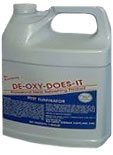
Home
How to use
MSDS
Purchase
Contact
About Us
Testimonials
Photo Gallery
Removing Rust
Questions


|
8 Oz. Trial Size |
$7.95 |
|
Half Gallon |
$17.95 |
|
1 Gallon |
$27.95 |
|
3 Gallon Case |
$77.95 |
|
5 Gallon container |
$124.95 |
|
55 Gallon Drum |
$949.95 |
Removing Rust Questions
Have a question we didn't answer? Review other customers questions or ask your own.
Removing Rust Questions - How does Deoxy-Does-It work?
Deoxy-Does-It works through a process known as selective chelation. This is a process in which a large synthetic molecule forms a bond with metals and holds them in solution. Most chelating agents bind many different metals. The active ingredient in Deoxy-Does-It bonds to iron exclusively. It can remove iron from iron oxide, but is too weak to remove iron from steel because the iron is held much more strongly.
How can I purchase De-oxy-Does-It?
You may call toll-free to 1-800-233-6573 fax your order to (440) 602-7203 or Click here for purchasing information
Can I spray it on?
Deoxy-Does-It is primarily designed to be used as a dip/soak, not a spray. Deoxy-Does-It only works in the liquid form. When sprayed on a surface that is heavily rusted the water in the solution may evaporate before de-rusting can be completed. It will be necessary to keep spraying the object in order to keep it wet with solution until the item is de-rusted. Deoxy-Does-It can also be sprayed on a rusty surface and scrubbed with a brush or pad, in order to greatly reduce the amount of scrubbing necessary to remove the rust. Another creative method is to setup a pump and catch basin and re-circulate the solution over the object to be de-rusted.
Do the parts need to be completely clean before immersion?
No, but we highly recommend it. Deoxy-Does-It has proprietary detergents which penetrate oils, greases and dirt. However, surface contaminants do slow the process. The soils must be penetrated before Deoxy-Does-It can come in contact with the rust underneath. Soil residue will also shorten the life of Deoxy-Does-It. Heavy greases and cosmoline should be removed prior to de-rusting.
What about surfaces too large to soak?
It is possible to use Deoxy-Does-It to remove rust from some surfaces too large to soak. An effective method is to saturate a fake chamois cloth, rag, or other tightly knit material in Deoxy-Does-It. Place the saturated material on/around the surface, evenly press to make sure the material is in contact with the surface, then cover with plastic to keep the material from drying out. This wrapping method is ideal for de-rusting large objects that cannot be dipped easily.
What about bluing and other coatings?
Deoxy-Does-It will remove sacrificial oxide coatings and is perfect for removing weapon finishes such as Bluing, Parkerizing, Zinc Phosphate, and Browning. Anodizing, Cobalt Tungsten Carbide, Powder Coating, Chrome, Nickel, Paint, and most other coatings will not be removed as long as they do not contain oxides. Deoxy-Does-It will not harm lead or solder points.
Are there any metals I should not soak in Deoxy-Does-It?
Deoxy-Does-It is not recommended for use on magnesium or magnesium alloys.
Can I use Deoxy-Does-It to clean brass, copper, and/or aluminum?
It depends on what you are trying to clean. Deoxy-Does-It will not damage any of these metals and will clean oils and other soils. However, it will not remove corrosion from them. It is designed to remove rust (oxides of Iron) only - removing rust questions.
How long does Deoxy-Does-It last?
One gallon of Deoxy-Does-It will remove 1 pound of pure, dry rust. That averages removing rust from approximately 600 pounds of light to moderately rusted steel. When not in use, it is best to cover (but not airtight) to keep out bugs. If any of the bath evaporates, simply add fresh water.
How do I know when the Deoxy-Does-It is spent?
The product will lose the ability to remove rust. The bath will turn completely black and will no longer perform.
How do I dispose of the spent solution?
If you have not introduced paint, grease, oil, or any other hazardous materials into the solution, only the iron content of the solution will dictate the disposal method. If the solution is used to clean iron and steel, the primary component added to the pH neutral solution will be iron oxide, a naturally occurring non-hazardous product. In most cases, the liquid portion of the solution may be rinsed into your drain or sewer system. The sediment portion containing most of the iron oxide solid is a non hazardous product safe for landfill disposal. It is recommended to check local & federal disposal requirements - removing rust questions.
Some pieces get a black film on them, what is it?
The black is carbon from the steel coming to the surface. Generally high carbon steel is used in making items that are flexible (e.g. springs, saw blades, etc.). High carbon steel and tool alloy steel items, when de-rusted, will have a darker appearance. The carbon film can either be left on, or it may be removed simply by wiping with a cloth or by scrubbing with a wire brush.
You're viewing the removing rust questions webpage.



